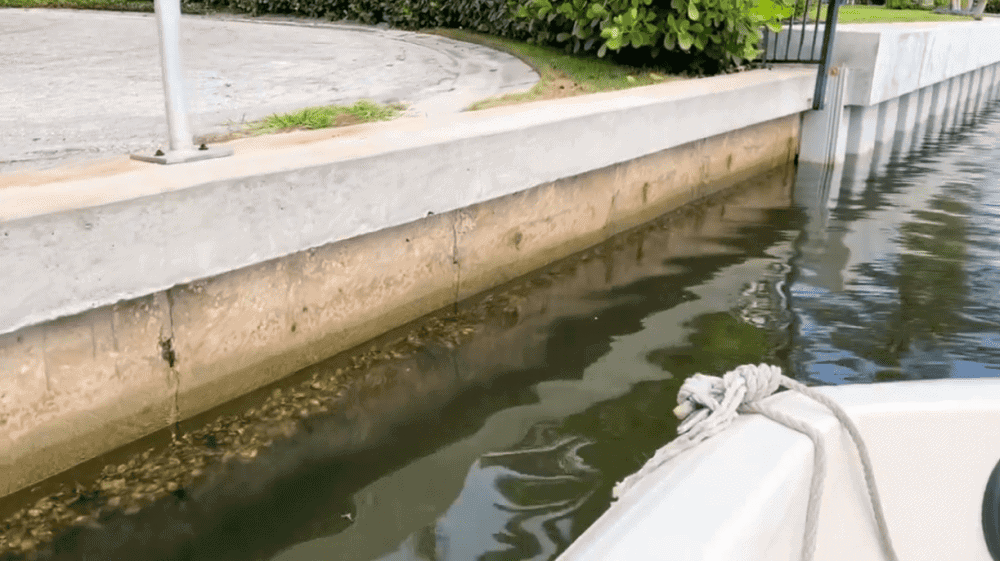
[Image above] Screenshot from a Sarasota Bay Estuary Program video that shows the difference between oyster attachment on concrete versus vinyl seawalls. Credit: Sarasota Bay Estuary Program
If you live along the coast, chances are you have heard or been involved in the ongoing debate about seawalls.
Seawalls are vertical onshore structures that are meant to protect populated land areas against tides, currents, waves, and storm surges. Unfortunately, while seawalls may protect the land behind it, study after study has shown that seawalls can cause increased erosion both in front of and adjacent to the seawall.
Nature-based solutions, such as cultivating oyster habitats and seagrass meadows, provide long-lasting resilience against the sea. However, (re)establishing healthy ecosystems takes time, which many cities do not have in the face of rapidly rising sea levels. As such, communities may rely temporarily on seawalls while implementing a long-term adaptive plan.
But seawalls are notoriously expensive to build and maintain. For this reason, vinyl seawalls have grown in popularity compared to traditional concrete due to being less costly and unsusceptible to salt water. Yet this budget-friendly solution may cause even more problems for the environment, according to Sarasota Bay Estuary Program staff.
The Sarasota Bay Estuary Program is a cooperative partnership among communities, researchers, and governments that strives to improve the health of Sarasota Bay, a lagoon located off the central west coast of Florida.
In June 2023, program director Dave Tomasko issued a note providing restoration project updates. It also described a small-scale study that he along with intern Tom Kane and public outreach manager Megan Barry conducted on the effect of vinyl seawalls on oyster populations.
Oysters are a crucial component of global ocean health. These animals not only filter and clean the surrounding water, but they can also serve as barriers to storms and tides, preventing erosion and protecting productive coastal ecosystems.
Oysters were once plentiful in coastal areas throughout the United States. But decades of overfishing, habitat loss, pollution, and disease proved devasting for the mollusks, leaving oyster populations at historic lows.
Fortunately, significant progress is already being made toward oyster reef restoration thanks to initiatives, such as here, along the U.S. Atlantic and Gulf coasts.
In the recent small-scale study, Tomasko, Kane, and Barry observed 32 seawalls in the Sarasota Bay area, 16 concrete and 16 vinyl. Of the 16 concrete seawalls, all had many oysters growing on them. But only six of the 16 vinyl seawalls had any oysters attached, and only a few at that.
“It doesn’t look like they have the same capacity to allow oysters to attach,” Tomasko says in an Observer article. “And so that is not a good thing for the bay.”
As noted earlier, in ideal cases, seawalls should only be temporary structures that provide support while establishing permanent solutions, such as oyster reefs. But if communities use vinyl seawalls rather than concrete seawalls to reduce costs, this study shows how it could hinder the establishment of long-term solutions.
Tomasko says they are not sure why oysters are failing to attach to vinyl seawalls. But they suggest it could be due to the vinyl being too smooth, in which case manufacturers could “roughen up” the surface in some manner. Alternatively, there could be additives in the vinyl that are toxic to oysters, in which case different additives could be used.
“We are WAY early on this topic, and we do not know all that we need to know. But the TAC [Technical Advisory Committee] members today shared the concern that we have, and we would be remiss if we did not mention this as a relevant topic to raise with policy makers and regulators—as well as the general public,” Tomasko says in the director’s note.
Author
Lisa McDonald
CTT Categories
- Cement
- Environment


